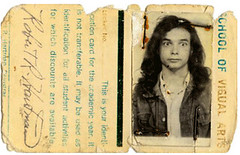 Daniel Maurer Original tilework from Ratner’s
Daniel Maurer Original tilework from Ratner’sThe Met Foods on Second Avenue will soon be reborn as Metropolitan Citymarket, complete with photo murals paying tribute to Ratner’s and the Fillmore East. The new signage has already been installed, but it’s covered by a gigantic plastic tarp and won’t be unveiled until fall. That’s because N.Y.U., the building’s owner, is about to cast the store in the shadow of its scaffolding. But there’s something you can feast your eyes on in the meantime: original tilework from Ratner’s restaurant.
Michael Schumacher, who owns and manages the store with his brother Steven (their father, Sam, took it over in 1986), said the supermarket’s overhaul was long overdue. In 2004, he explained, he was told by N.Y.U. that the store’s lease wouldn’t be renewed, and its appearance went into decline. “They told us four years prior that we weren’t getting a lease in 2008, so it was the nail in the coffin,” he said.
But as stories in The Villager recounted, N.Y.U. eventually renewed the lease for 15 years after much public outcry and intervention from public officials (Mr. Schumacher said his rent was raised by 20 percent). That left the grocers free to revamp. In gutting the store, they found remnants of Ratner’s, the 24-hour dairy restaurant that once occupied the space. Its original tilework now gleams on either side of the front entrance. Read more…
Robert Hughes once described the weekly paste-up night at The East Village Other as “a Dada experience.” The year was 1970 and while none of us who were toiling into the wee hours of the morning at one of America’s oldest underground papers (founded in 1965) knew what he was talking about, we nevertheless assumed that to get Time’s then newly appointed art critic to spend some of his first weeknights in America with us, we were doing something weird and perhaps even important. “Dada was the German anti-art political-art movement of the 1920s,” he explained in his cool Australian accent. “And this is the closest thing I’ve come to seeing it recreated today. I’m really grateful for the chance to be here.”
Yet he needn’t have been so grateful. He was as welcome as any other artist, writer, musician, hanger-on and at that moment, detective Frank Serpico, the most famous whistle-blowing cop in America, was stationed at the local Ninth Precinct and would came around periodically in his various undercover costumes to schmooze with the EVO staffers. Paste-up night was open to anybody who drifted up to the dark loft above Bill Graham’s Fillmore East, a former Loews Theater turned rock palace on Second Avenue and Sixth Street, just next door to Ratner’s famous dairy restaurant, in a neighborhood that in the Thirties was the heart of New York’s Yiddish Theater. At that time it was the East Coast hippie capital.
Beginning at seven or eight o’clock at night and lasting until dawn, the regular and transient layout staff took the jumble of counterculture journalism and anti-establishment diatribe that was the paper’s editorial meat and threw it helter skelter onto layouts that were pretty anarchic. Anyone could join in whether they had graphic design experience or not, yet many of the gadfly layout artists were too stoned to complete their pages which were finished on the long subway ride to the printer deep inside Brooklyn. Read more…






